Identifying Reservoir Features via iSOR Response Behaviour
Abstract
1. Introduction
- (1)
- (2)
- (3)
- (4)
- (5)
- Merging of non-uniform steam chambers at one or more points along two adjacent well pairs can lead to reinforcement of non-uniform conformance along one or both well pairs,
- (6)
- (7)
2. Reservoir Simulation Model
3. Results and Discussion
3.1. Case 1: Base Case
3.2. Case 2: Lean Zone
3.3. Case 3: Top Gas Zone
3.4. Case 4: Shale Layer
4. Conclusions
Author Contributions
Funding
Institutional Review Board Statement
Informed Consent Statement
Data Availability Statement
Acknowledgments
Conflicts of Interest
References
- Butler, R.M. Steam-Assisted Gravity Drainage: Concept, Development, Performance and Future. SPE Repr. Ser. 2008, 61, 44–50. [Google Scholar] [CrossRef]
- Butler, R.M. Thermal Recovery of Oil and Bitumen; Prentice-Hall Inc.: Upper Saddle River, NJ, USA, 1991; ISBN 9780139149535. [Google Scholar]
- Gates, I.D. Basic Reservoir Engineering; Kendall Hunt Publishing Company: Dubuque, IA, USA, 2011. [Google Scholar]
- Zhou, S.; Huang, H.; Liu, Y. Biodegradation and origin of oil sands in the western Canada sedimentary basin. Pet. Sci. 2008, 5, 87–94. [Google Scholar] [CrossRef]
- Khan, M.A.B.; Mehrotra, A.K.; Svrcek, W.Y. Viscosity Models for Gas-Free Athabasca Bitumen. J. Can. Pet. Technol. 1984, 23, 47–53. [Google Scholar] [CrossRef]
- Gates, I.D.; Larter, S.R. Energy efficiency and emissions intensity of SAGD. Fuel 2014, 115, 706–713. [Google Scholar] [CrossRef]
- Millington, D. Study No. 183: Canadian Oil Sands Supply Projects Development Costs (2019–2039); Canadian Energy Research Institute: Calgary, AB, Canada, 2019; p. 53. [Google Scholar]
- Gates, I.D.; Chakrabarty, N. Optimization of Steam-Assisted Gravity Drainage (SAGD) in Ideal McMurray Reservoir. J. Can. Pet. Technol. 2006, 45, 54–62. [Google Scholar] [CrossRef]
- Gates, I.D.; Kenny, J.; Hernandez-Hdez, I.L.; Bunio, G.L. Steam Injection Strategy and Energetics of Steam-Assisted Gravity Drainage. SPE Reserv. Eval. Eng. 2007, 10, 19–34. [Google Scholar] [CrossRef]
- Bao, Y. On Steam Based Recovery Process Design. Ph.D. Thesis, University of Calgary, Calgary, AB, Canada, 2015. [Google Scholar]
- Guo, T.; Wang, J.; Gates, I.D. Pad-scale control improves SAGD performance. Petroleum 2018, 4, 318–328. [Google Scholar] [CrossRef]
- Su, Y.; Wang, J.; Gates, I.D. SAGD Well Orientation in Point Bar Oil Sands Deposit Affects Performance. Eng. Geol. 2013, 157, 79–92. [Google Scholar] [CrossRef]
- Su, Y.; Wang, J.; Gates, I.D. Orientation of a Pad of SAGD Well Pairs in an Athabasca Point Bar Deposit Affects Performance. Mar. Pet. Geol. 2014, 54, 37–46. [Google Scholar] [CrossRef]
- Su, Y.; Wang, J.; Gates, I.D. SAGD Pad Performance in a Point Bar Deposit with a Thick Sandy Base. J. Pet. Sci. Eng. 2017, 154, 442–456. [Google Scholar] [CrossRef]
- Wei, W.; Gates, I.D. On the Relationship between Completion Design, Reservoir Characteristics, and Steam Conformance Achieved in Steam-Based Recovery Processes Such as SAGD. SPE-DOE Improv. Oil Recovery Symp. Proc. 2010, 1, 460–476. [Google Scholar]
- Lastiwka, M.; Bailey, C.; James, B.; Zhu, D. A practical approach to the use and design of flow control devices in SAGD. In Proceedings of the Society of Petroleum Engineers-SPE Canada Heavy Oil Technical Conference, Calgary, AB, Canada, 7–9 June 2017; pp. 777–789. [Google Scholar] [CrossRef]
- Alturki, A.A.; Gates, I.D.; Maini, B.B. Co-injection of non-condensable gas improves ES-SAGD performance in shallow oil sands reservoirs with a small top water zone. In Proceedings of the Society of Petroleum Engineers-Canadian Unconventional Resources and International Petroleum Conference, Calgary, AB, Canada, 19–21 October 2010. [Google Scholar]
- Austin-Adigio, M.; Gates, I.D. Non-Condensable Gas Co-Injection with Steam for Oil Sands Recovery. Energy 2019, 179, 736–746. [Google Scholar] [CrossRef]
- Gates, I.D.; Leskiw, C. Impact of Steam Trap Control on Performance of Steam-Assisted Gravity Drainage. J. Pet. Sci. Eng. 2010, 75, 215–222. [Google Scholar] [CrossRef]
- Edmunds, N.; Chhina, H. Economic Optimum Operating Pressure for SAGD Projects in Alberta. J. Can. Pet. Technol. 2001, 40, 13–17. [Google Scholar] [CrossRef]
- Pinto, H.; Wang, X.; Gates, I.D. Insights on Heat Transfer at the Top of Steam Chambers in SAGD. J. Heat Transf. 2017, 139, 041801. [Google Scholar] [CrossRef]
- Gotawala, D.R.; Gates, I.D. On the Impact of Permeability Heterogeneity on SAGD Steam Chamber Growth. Nat. Resour. Res. 2010, 19, 151–164. [Google Scholar] [CrossRef]
- Vinsome, P.K.W.; Westerveld, J. A Simple Method for Predicting Cap and Base Rock Heat Losses in Thermal Reservoir Simulators. J. Can. Pet. Technol. 1980, 19, 87–90. [Google Scholar] [CrossRef]
- CMG STARS™ User’s Manual; Version 2019; Computer Modelling Group Ltd.: Calgary, AB, Canada, 2019.
- Yuan, J.Y.; Chen, J.; Pierce, G.; Wichar, B.; Golbeck, H.; Wang, X.; Beaulieu, G.; Cameron, S. Noncondensable Gas Distribution in SAGD Chambers. J. Can. Pet. Technol. 2011, 50, 11–20. [Google Scholar] [CrossRef]



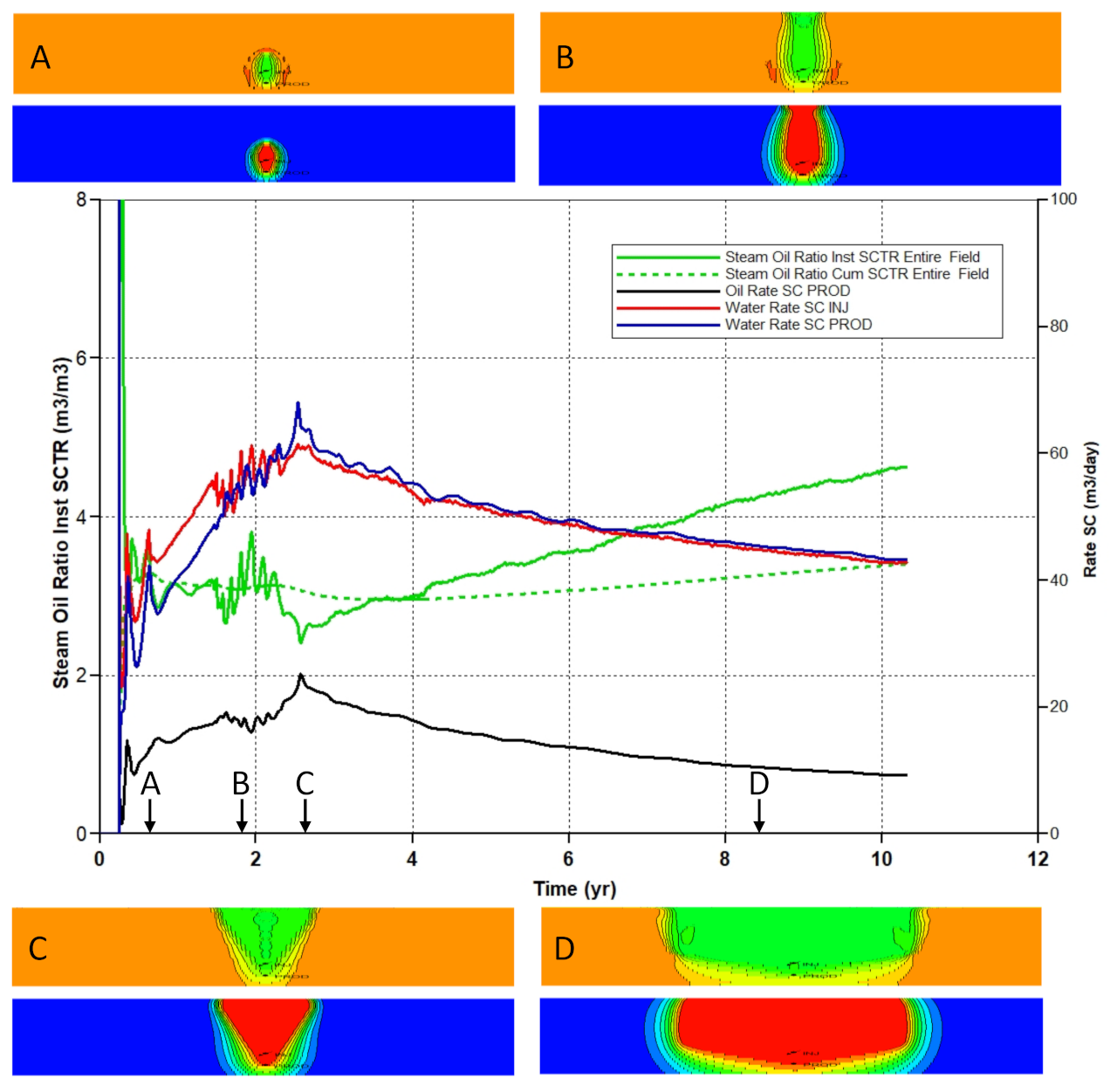
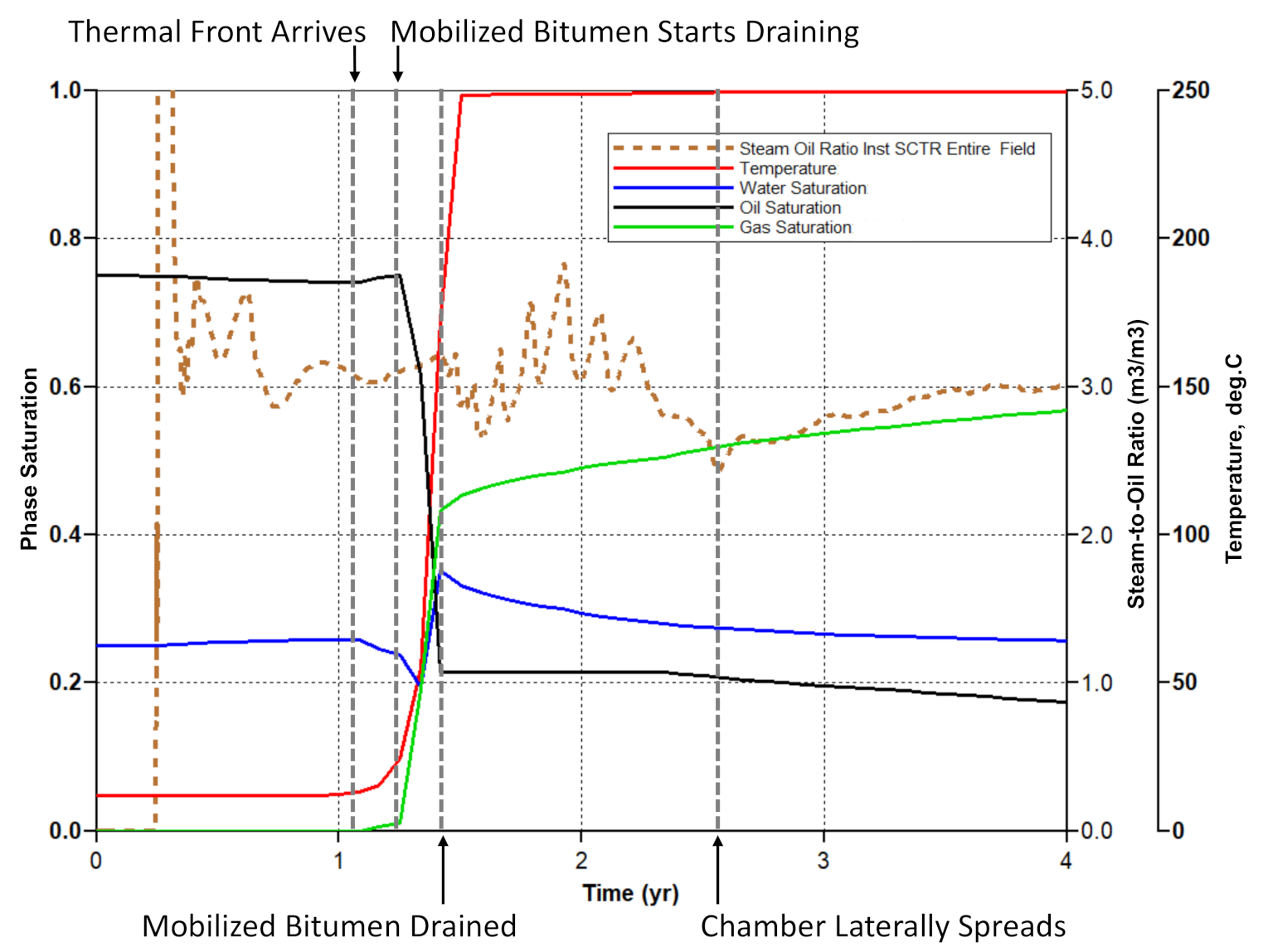

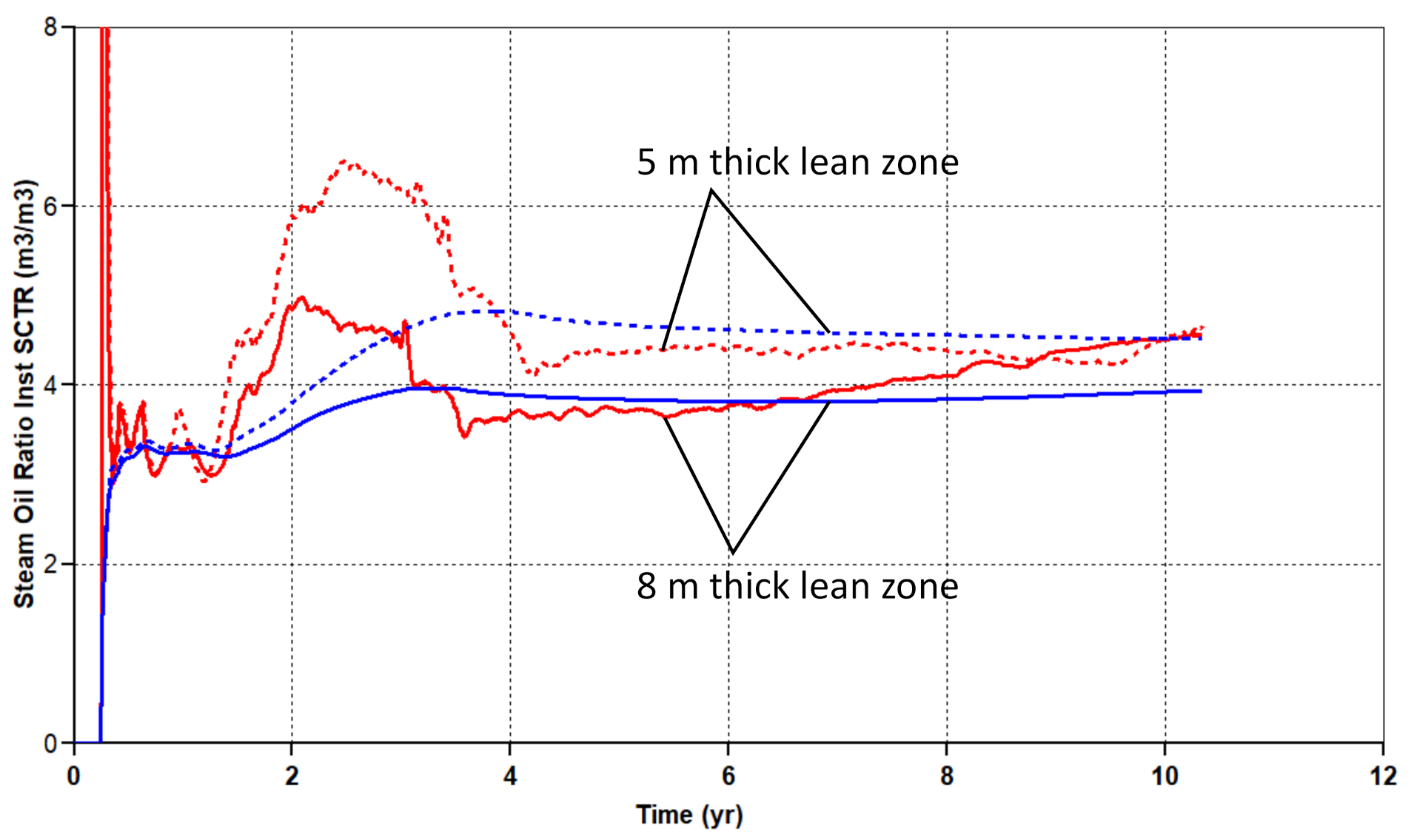
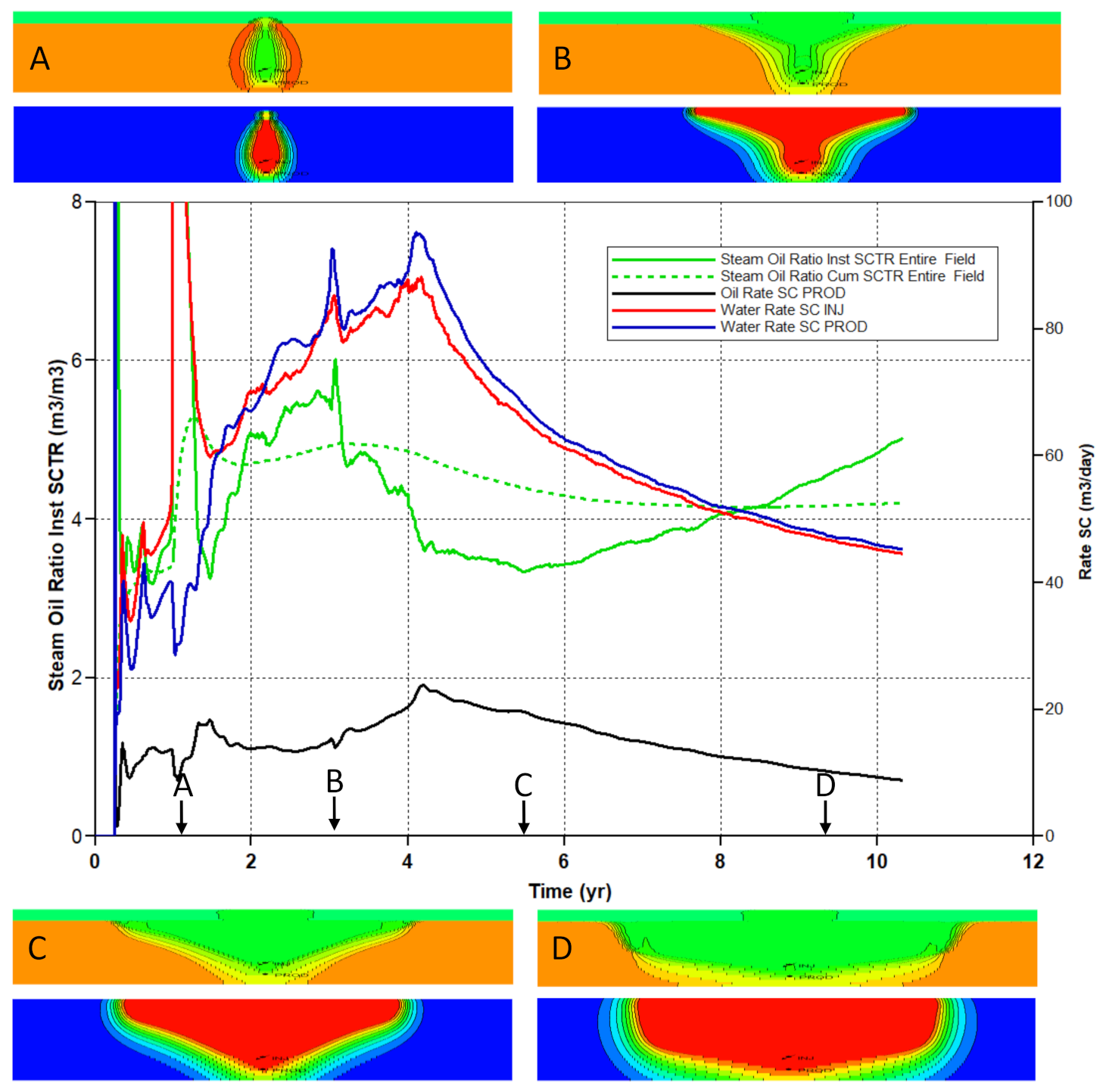
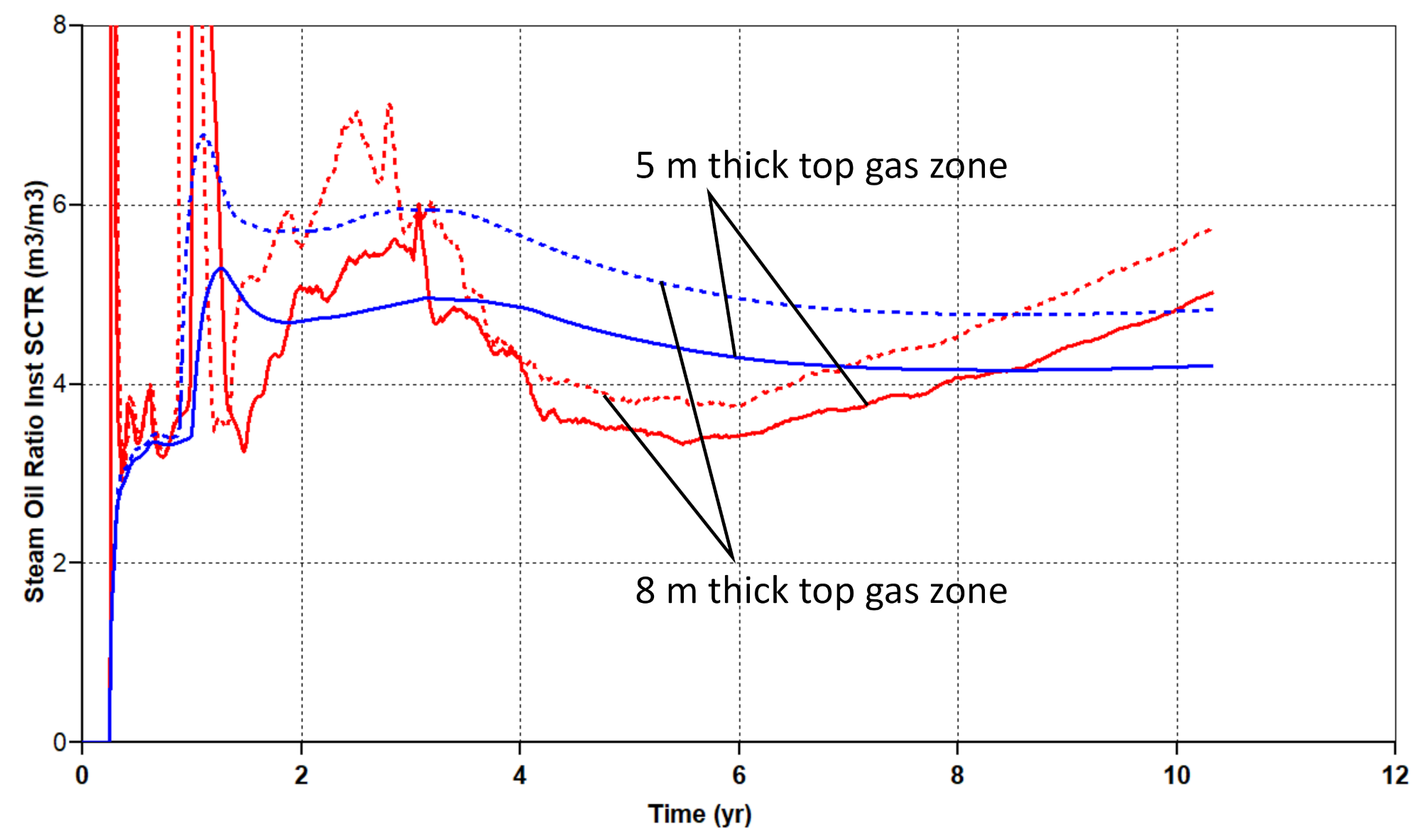


| Item | Value |
|---|---|
| Steam circulation (pre-heat) period, months | 3 |
| SAGD operation period, years | 10 |
| Initial reservoir temperature, °C | 12 |
| Initial reservoir pressure at depth 350 m, kPa | 3000 |
| Initial oil saturation | 0.75 |
| Porosity | 0.3 |
| Horizontal permeability, mD | 3000 |
| Vertical-to-horizontal permeability ratio | 0.5 |
| Sorw | 0.2 |
| Swc | 0.15 |
| Sorg | 0.15 |
| Sgc | 0.05 |
| krwro | 0.1 |
| krocw | 0.992 |
| krogc | 0.992 |
| krg(Sorg) | 1.0 |
| Reservoir rock and overburden/understrata heat capacity, kJ/m3 °C [2] | 2600 |
| Reservoir rock and overburden/understrata thermal conductivity, kJ/m day °C [2] | 660 |
| Bitumen thermal conductivity, kJ/m day °C [2] | 11.5 |
| Water thermal conductivity , kJ/m day °C [2] | 53.5 |
| Gas thermal conductivity , kJ/m day °C [2] | 5.0 |
| Bitumen viscosity correlation, cP, T in °C | A = −9.1919
B = 7.3008 C = −0.917 |
| Solution Gas to Oil Ratio, m3/m3 | 2 |
| Methane K-value correlation, K-value = [24] | kv1 = 5.4547 × 105 kPa
kv4 = −879.84 °C kv5 = −265.99 °C |
| Item | Equation | |
|---|---|---|
| Multiphase flow in porous media (Darcy’s law) | ||
| Potential | ||
| Material balance (equation of flow) | ||
| Conductive heat transfer | ||
| Energy balance | +) + +) + +]) = | |
| Symbol definitions | Subscripts w, o, and g refer to the water, oil, and gas phases, respectively | |
| velocity of phase | ||
| k* | effective permeability tensor of phase | |
| viscosity | ||
| potential gradient of phase | ||
| acceleration due to gravity | ||
| density | ||
| elevation above datum location | ||
| , | solution-gas ratios in oil or water phases, respectively | |
| , , | effective permeabilities of oil, water and gas, respectively | |
| , , | formation volume factors for oil, water, and gas, respectively | |
| q | heat transfer flux | |
| kth | thermal conductivity tensor | |
| T | temperature | |
| hi | enthalpy of each phase | |
| volumetric heat capacity of reservoir solids | ||
| specific internal energy of each phase | ||
| Q | energy input per unit volume | |
Publisher’s Note: MDPI stays neutral with regard to jurisdictional claims in published maps and institutional affiliations. |
© 2021 by the authors. Licensee MDPI, Basel, Switzerland. This article is an open access article distributed under the terms and conditions of the Creative Commons Attribution (CC BY) license (http://creativecommons.org/licenses/by/4.0/).
Share and Cite
Wang, J.; Gates, I. Identifying Reservoir Features via iSOR Response Behaviour. Energies 2021, 14, 427. https://doi.org/10.3390/en14020427
Wang J, Gates I. Identifying Reservoir Features via iSOR Response Behaviour. Energies. 2021; 14(2):427. https://doi.org/10.3390/en14020427
Chicago/Turabian StyleWang, Jingyi, and Ian Gates. 2021. "Identifying Reservoir Features via iSOR Response Behaviour" Energies 14, no. 2: 427. https://doi.org/10.3390/en14020427
APA StyleWang, J., & Gates, I. (2021). Identifying Reservoir Features via iSOR Response Behaviour. Energies, 14(2), 427. https://doi.org/10.3390/en14020427






